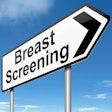Dear AuntMinnie Member,
Rates of mammography screening dropped 6% in the year following the 2009 guideline change on breast screening from the U.S. Preventive Services Task Force (USPSTF).
That's according to a new article in our Women's Imaging Community by researchers from the Harvey L. Neiman Health Policy Institute, who analyzed changes in the rate of mammography screening after the 2009 guideline switch. In addition to the 6% drop the year after the change, rates remained low three years later.
The findings are particularly salient as the breast imaging community debates USPSTF's announcement last month that it intends to keep its screening guidelines largely the same with its 2015 revision. As a result, many women may not receive breast screening -- including some who fall within the task force's age range. Learn more by clicking here.
While you're in the community, check out a new story that indicates the breast density notification movement may want to tweak its approach. Researchers from the University of California, San Francisco (UCSF) found that using only breast density to determine which women should receive follow-up studies may result in the scanning of many women who are actually at low risk of developing cancer.
The UCSF team is calling for a more tailored approach, in which breast density is used in combination with other breast cancer risk factors to determine which women should receive follow-up imaging. Click here to read more, or visit the community at women.auntminnie.com.
Medicare spending drops
In other news, a presentation at the American College of Radiology's ACR 2015 meeting this week in Washington, DC, indicates that Medicare spending on medical imaging has dropped in recent years, but it has been falling at different rates in different states.
Researchers from NYU Langone Medical Center tracked Medicare spending per beneficiary from 2004 to 2012 and found that spending on imaging increased almost 8% per year from 2004 to 2006, but then fell by 4.4% per year through 2012.
The states with the highest rates of Medicare spending included Florida, Nevada, and New York, while those with the lowest rates in recent years included Ohio, Vermont, and Idaho. Get the rest of the details by clicking here.



















